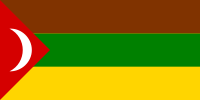Emirate of Beihan
| Emirate of Beihan إمارة بيحان | |||||
| State of the Federation of South Arabia | |||||
| |||||
|
Flag | |||||
 | |||||
| Capital | Suq Abdulla, (now Beihan) 13°25′N 45°40′E / 13.417°N 45.667°ECoordinates: 13°25′N 45°40′E / 13.417°N 45.667°E | ||||
| Government | Monarchy | ||||
| History | |||||
| • | Documented since | 1680 | |||
| • | Disestablished | 1967 | |||
Beihan or Bayhan (Arabic: بيحان Bayḥān), officially the Emirate of Beihan (Arabic: إمارة بيحان Imārat Bayḥān), was a state in the British Aden Protectorate and the Federation of South Arabia. Its capital was Suq Abdulla, now called Beihan. The Emirate was abolished in 1967 upon the founding of the People's Republic of South Yemen and is now part of the Republic of Yemen.[1]
Geography
Beihan is a valley connected between al-Baidha in the north-west, Ma'rib in the east and Ataq in the south. It is a fertile valley irrigated by water streams fall from the northern mountains as well as from the dug wells. The main cultivated crops are dates, cereals and citrus and people depend on livestock to a large extent to survive. Nonetheless, people increasingly adopt trade and exchange commerce; in addition to incorporate to the government business.
History
Bayhan valley historically had several main groups. The Musabein Tribe living in the south which was dominated by Al-Saleh (Ahmed Saif tribe) and the Alfatima (Naji Alawi tribe). These two factions were engaged in constant feuds. Historically the middle of the valley was populated by the Al-Habieli family, descendants of the Prophet, who arrived in the valley in the late 1600s. They had been sent by the Imam of Yemen to protect the trade routes.
The Al-Habieli family are direct descendants of the first, al Hadi Yahya bin Hussein, and seventh, Qassim al Mansur bin Abdullah, Imams of Sana'a.
The north of the valley was dominated by the Balharith Tribe who were also continuously fighting one another as to who was their paramount sheik and like the Masabin also split into 2 main branches.
Rulers
The ruling Al-Habieli family, recognized by the Hashimite Grand Sharifs of Mecca as related, established themselves as religious leaders in Bayhan in 1680 and became independent. The Hashemite Emirate of Bayhan was included in the Western Aden Protectorate before joining the Federation of Arab Emirates of the South on 11/2/1959 and the Federation of South Arabia on 4/4/1962. The Emirate was abolished by revolutionary Yemen in 7/1967 (the People's Republic of South Yemen on 30/11/1967). Capital was Naqub. Al Amir Talal Saleh Hussein Al-Habieli is current dynastic head of the family.
Emirs
The former rulers were: [2]
- Muqbil, 1st Amir of Bayhan 1680-
- Amir Hasan.
- c.1750 - 1800 Amir Ghalib.
- c.1800 - 1820 Amir Hussein.
- .... - .... Amir al Habieli.
- Amir Saifallah.
- Amir Mubarak.
- .... - 1903 Amir Muhsin
- Sharif Ahmad Muhsin Al Habieli, Amir of Bayhan 1903-abdicated 1935, independent c 1900. Father of: HE Sharif Hussein Ahmad Al Habieli, Regent of the Hashemite Emirate of Bayhan 1935-1967, formerly Minister of Interior of the Federation of South Arabia. HE Sharif Hussein was married to Halima, daughter of the Sheikh of the Musabein tribe. Their son, HH Sharif Saleh al Hussein Al Habieli (1935-Feb 2010), Amir of Bayhan, deprived of ruling powers on 28/8/1967 by revolutionary Yemen (the People's Republic of South Yemen on 30/11/1967).
- Prince Al Amir Talal Saleh Hussein Al-Habieli current Heir Apparent(Feb 2010–present).
- Princess Diane Carol Al-Habieli resides in USA.
See also
References
- ↑ Paul Dresch. A History of Modern Yemen. Cambridge, UK: Cambridge University Press, 2000
- ↑ States of the Aden Protectorates
